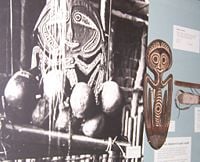Headhunting
- This is about headhunting as a cultural practice. For other uses, see Headhunter (disambiguation).
A headhunter was a person who killed another and then took the other's head. Headhunting was practiced in the precolonial era in parts of Nigeria, Nurestan, Assam, Myanmar, Borneo, Indonesia, the Philippines, Taiwan, Micronesia, Melanesia, New Zealand, the Amazon Basin, and among certain sects of the Celts of ancient Europe. Today it is a universally prohibited practice, and appears to have died out as of the mid-20th century.
As a practice, headhunting has been the subject of intense discussion within the anthropological community as to its possible social roles, functions and motivations. Contemporary scholars generally agree that its primary function was ceremonial, and that it was part of the process of structuring, reinforcing and defending hierarchical relationships between communities and individuals. The debate is about the finer detail. Some believe that it was practiced because of a belief that the head contained "soul matter" or life force that could be harnessed through its capture. Themes that arise in anthropological writings about headhunting include mortification of the rival, ritual violence, cosmological balance, the display of manhood, cannibalism and prestige.
Southeast Asia and Melanesia

Headhunting was practiced in many parts of Southeast Asia. Anthropological writings exist on the Ilongot, Iban, Dayak, Berawan, Wana, Mappurondo, and others. Among these groups, headhunting was usually a ritual activity rather than an act of war or feuding, and involved the taking of a single head. Headhunting acted as a catalyst for the cessation of personal and collective mourning for the community's dead. Ideas of manhood were wrapped up in the practice and the taken heads were prized.
Kenneth George (1996) wrote about annual headhunting rituals that he observed among the mappurondo religious minority, an upland tribe in the south-west part of the Indonesian island of Sulawesi. Actual heads are not taken; instead, surrogate heads are used, in the form of coconuts. The ritual, called pangngae, takes place at the conclusion of the rice harvesting season. It functions to bring an end to communal mourning for the deceased of the past year, express intercultural tensions and polemics, allow men to display manhood, distribute communal resources, and resist outside pressures to abandon mappurondo lifeways.
Around the 1930s, headhunting was suppressed among the Taiwanese aborigines during the Japanese occupation of Taiwan and among the Ilongot in the Philippines by the US authorities. In Sarawak on the island of Borneo, the colonial dynasty of James Brooke and his descendants eradicated headhunting in the hundred years before World War II.
Some believe that Michael Rockefeller may have been taken by headhunters in western New Guinea as recently as 1961.
Amazon
The Shuar in Amazonian Ecuador and Peru practiced headhunting in order to make shrunken heads and use them for ritual purposes. The practice is no longer current, but the Shuar still produce replica heads which they sell to tourists.
New Zealand
In what is now known as New Zealand, the Māori would preserve the heads of enemies, removing the skull and smoking the head. Māori are currently attempting to reclaim the heads of their ancestors held in museums outside New Zealand.
China
During the Spring and Autumn Period and Warring States Period, Qin soldiers were prone to collect their enemies' heads. Since most of the soldiers were slaves, they and their families could be freed from slavery and even secure promotions in the army by returning victorious with heads. The act of Qin soldiers carrying heads in battles usually terrified their foes. This is why headhunting is one of the factors in the Qin dynasty defeating six other nations and unifying China.
After the Qin dynasty, headhunting ceased to be practiced amongst Chinese people.
Celts
The Celts of Europe practiced headhunting for an indeterminate religious reason. Romans and Greeks recorded their habits of nailing heads of personal enemies to walls, or dangling them from the necks of horses, and human skulls are found amongst votive offerings. Headhunting was still, in a form, practiced for a great deal longer by the demi-Celtic Gaels, though this was probably more traditional than religious, as the religious reasons for collecting the heads was likely lost after their conversion to Christianity. Heads were also taken among the Germanic tribes and Iberians, but the purpose is unknown.
ReferencesISBN links support NWE through referral fees
- Kenneth George (1996). Showing signs of violence: The cultural politics of a twentieth-century headhunting ritual. Berkeley: University of California Press. ISBN 0-52020-041-1
See also
External links
Credits
New World Encyclopedia writers and editors rewrote and completed the Wikipedia article in accordance with New World Encyclopedia standards. This article abides by terms of the Creative Commons CC-by-sa 3.0 License (CC-by-sa), which may be used and disseminated with proper attribution. Credit is due under the terms of this license that can reference both the New World Encyclopedia contributors and the selfless volunteer contributors of the Wikimedia Foundation. To cite this article click here for a list of acceptable citing formats.The history of earlier contributions by wikipedians is accessible to researchers here:
The history of this article since it was imported to New World Encyclopedia:
Note: Some restrictions may apply to use of individual images which are separately licensed.